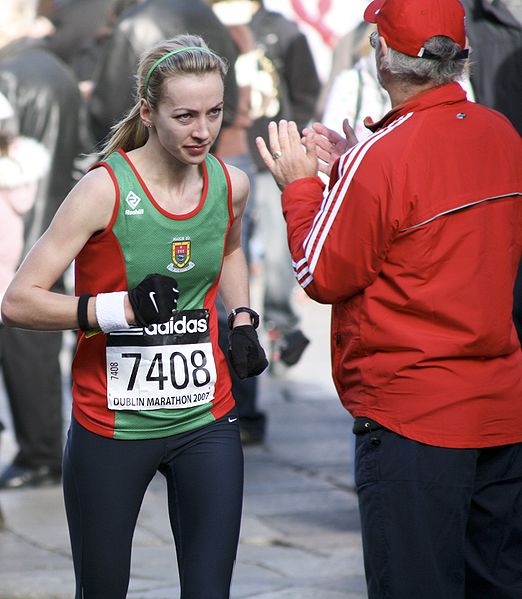HIIT vs. Steady-state Cardio
 Thursday, January 8, 2009 at 10:36PM
Thursday, January 8, 2009 at 10:36PM Let’s talk cardio for a bit. It’s the kind exercise that is probably the least understood while being the one most often used in the gym. It never fails that I will walk into my admittedly small gym and find the treadmills and elliptical trainers nearly fully populated (while the free weights and weight machines are sitting empty) with people busily pumping along at a steady pace.
For the record, there are basically 2 ways to perform cardiovascular exercise: slow to medium speed/long duration and high point/short duration. Each has a pretty specific effect on body composition, but not all effects yield desired results. There are infinite variations on the basics above, but these two are the ones that have been the focus of previous study, which is why I will spend time in this article on each.
Steady State Training
As the name indicates, the basics of SS training include long periods of time (45 min or longer) at a relatively steady speed. The participant will breathe heavily and work up a sweat, so the immediate evidence for work under these exercise conditions is there. The body actually does burn fat under these exercise conditions; one need only look at your average distance runner to find proof of this fact. Finding a serious 10K runner with a midriff spare-tire isn’t exactly a simple thing to do.
SS cardio targets the slow-twitch muscle fibers that are utilized primarily for endurance events. Slow-twitch muscle fibers use oxygen to create fuel, thus providing the athlete with a long-lasting ongoing supply of energy, which is perfect for the grueling length of marathons and other such events.
The immediate problem of SS cardio is that in addition to consuming fat, the body consumes protein (muscle) in order to keep the body fueled for the lengthy training session. If our goal is to look good on the beach this summer, muscle is actually a good thing. This makes the idea of trudging along for an hour on a treadmill or elliptical seem fairly counterintuitive. Now, if your goal is to complete a marathon, then obviously this is the kind of training you want to pursue. It’s not my goal, which is all well and good for me. The photo below is a good example of the body that is developed with steady-state cardio training.
Notice the spindle-like limbs and gaunt facial features of this runner. Granted she is in great physical shape with exceptionally low body fat percentages. Hers is not the type of physique I aspire to create, however, so I'll leave this kind of training to those who desire to complete longer events.
One word of caution about steady state cardio: as I’ve already mentioned, SS cardio has a detrimental effect on muscle mass. As the body consumes protein for fuel, it significantly weakens the muscle tissue that it so desperately needs to keep going. Consider that the heart is a muscle and suffers the same weakening as is experienced by any other skeletal muscle tissue in the body. A quick search reveals stories from March 2, 2009, Nov. 3, 2008, Nov. 7, 2007, and Oct. 8, 2007 describing the deaths of marathoners (including 2 runners in the 2008 story) in just the last 30 months. Each of the runners died as a result of some form of heart condition. There are likely dozens more stories like these that make the news, and far more that never get reported. The truth of the matter is simple - long duration cardio is a crap-shoot as far as its health benefits are concerned. Sure marathoners are not fat, but they’re not exactly the most aesthetically pleasing athletes to look at, either.
High Point/Short Duration
Much has been said about the effects of HP/SD cardio (also called HIIT, or high intensity interval training), some of it bordering on the fantastic and the rest a little more on the plausible side. I’ll stick to the claims that have at least a shred of credibility to them.
HIIT is identified by the occurrence of brief periods of high-intensity output interspersed between periods of low intensity recovery time. For example, my HIIT sessions on the treadmill include a 5-minute warm up followed by 60 seconds at 9 mph (intensity interval). That 60 seconds is followed by 2 minutes at 5 mph (recovery interval). I repeat that cycle five times with the last high-intensity interval lasting 2 minutes. I complete the workout with a 2 minute recovery interval and a 3 minute cool down. The length of the intervals is dependent on the level of conditioning of the participant. Shorter intervals (30-second high points with 2-minute recovery phases) might be preferential for the less-conditioned participant. High-intensity intervals should not exceed 2 minutes, or they’re not high enough to be considered “high” intensity. By the time the participant gets to the last high point, they should be really working at 100% effort.
Once again, the proof of the efficacy of HIIT cardio can be seen in the types of athletes that utilize this type of training on a regular basis. Consider the physical appearance of football wide receivers and sprinters in particular. Their physiques would be most accurately defined as lean and muscular with well defined musculature. Sprinters and wide receivers run drills that have them performing at maximum effort for a short burst with a longer cool-down period between each drill. The result of this training is a defined physique with more muscle mass, as seen in the photo of Usain Bolt.
 Notice the difference between Bolt's arms and those of the distance runner. He has distinctly muscular features - the bulging biceps give themselves away in this shot. What you can't see in this shot is the ripped midsection he sports in addition to a very muscular pair of legs. His is the type of physique I prefer to create for myself.
Notice the difference between Bolt's arms and those of the distance runner. He has distinctly muscular features - the bulging biceps give themselves away in this shot. What you can't see in this shot is the ripped midsection he sports in addition to a very muscular pair of legs. His is the type of physique I prefer to create for myself.
Back to HIIT. Another additional benefit of intensity training is something that is known as the after-burn. After-burn is simply the continuation of caloric burn for a period of time after the workout has ended. Depending on the intensity of the workout, after-burn can continue for one to several hours after the workout has ended. If you’re one of those people who counts calories burned by watching the calorie counter on the treadmill, then HIIT is going to blow that number away. With a serious HIIT workout, you might burn up to three times the calories shown on the calorie counter.
The best thing about HIIT is that it takes so little time. Workouts generally last no longer than 30 minutes; good HIIT workouts can be as short as 10-15 minutes for those who are just starting the process of physique transformation. I personally utilize a 25 minute HIIT regimen that looks like this:
5-minute warm up at a level 4 (on a scale of 1-10)
2 minutes at a level 5, which for me right now is about 6 mph on a treadmill
1 minute at a level 9, which for me is currently 9.5 mph
10 minutes - repeat the 2-minute/1-minute split 3 more times (4 times total). On the 4th repetition of the split, instead of 1 minute at level 9, I extend that to 2 minutes to reach a level 10.
2 minutes at level 5
5-minute cool down at level 4
Frank, who works the desk at my gym, frequently comments about the shortness of my workouts on HIIT days. Perhaps it’s because he sees so many people coming to the gym and spending 30 to 60 minutes on elliptical trainers and treadmills. I always tell him the same thing: it doesn’t take longer than 25 minutes to get a good cardio workout. Anything longer than that is just wasting time and effort.
Summing It Up
There are clear choices when it comes to cardiovascular training. If you’re training for an endurance event like a marathon, then you definitely want to engage in responsible steady-state training. If having a more defined muscular physique is your goal, then HIIT is the type of training that can help you reach that goal.
For sample HIIT workouts, read my article: HIIT Workouts for Every Fitness Level.
As always, I welcome your comments and questions. Be well!
![]() Like this article?
Like this article?
Buy us a Fat-Free Latte!
 Keith |
Keith |  3 Comments |
3 Comments | 

